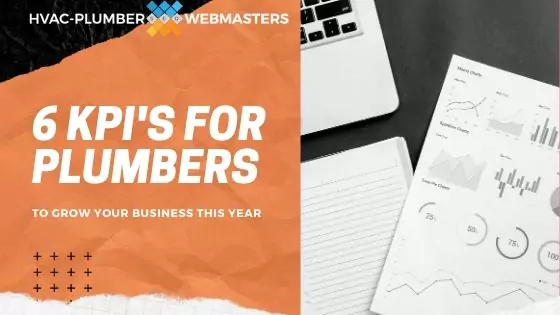What Are Plumber KPIs?
A KPI for plumbers, or Key Performance Indicator, is a measurable figure showcasing how effectively or ineffectively your business reaches its target goals.

Best Key Performance Indicators for Plumbing Companies
It isn’t enough to offer the best plumbing services possible. It should be enough, and it would be in a perfect world.
However, in the real world, plumbing business success requires professional plumbing services and tracking your performance in real time.
Keeping track of KPIs (Key Performance Indicators) is pretty much a part-time job. It’s essential, though, if you want to make sure your business is making a profit.
To help all the plumbers out there start to get a handle on what KPIs they should be tracking in 2025, HVAC-Plumber SEO Webmasters put together the following list.
1) Seasonal Revenue
Plumbing can be a very seasonal business – primarily if you service a part of the country that sees freezing temperatures.
So, it’s essential to track your sales revenue by season.
This will help you determine when the lulls are coming and when you are busier.
When you have identified your slow and peak season, you can begin to strategize to smooth the peaks and valleys out a bit.
For example, if you notice that you get fewer service calls in the summer, you should start looking into ways you and your employees can upsell customers.
Things like making people aware of how long their appliances likely have before they give out can help balance your slow season.
Remember that most people are looking to save money on their water, heating, and electricity bills.
Selling customers on plumbing upgrades could be another way to increase sales revenue during your slow season.
When calculating your seasonal or annual sales revenue, remember that this figure only refers to the money coming in from customers paying for the services or products you make available to them.
Seasonal revenue doesn’t refer to adjusted income after you’ve paid your employees, paid for your supplies, and operating costs.
2) Business Growth
Another critical KPI for plumbers is business growth.
This can be calculated in many ways, but the most effective is determining your yearly gross margins.
This is where you start to throw things like cost of operation and salaries into the equation.
To find your gross margins, subtract your total cost of operations (supply costs, fuel costs, etc.) from your total sales revenue and divide that figure by sales revenue again.
The final figure is your gross margin for that year.
It’s essential to keep good records of your annual gross margins so that you can compare them year by year.
You can convert the figures into percentages to see how much your business has grown or shrunk by percentage.
Here’s a little bonus tip: when calculating your gross margins, be careful not to include supplies you have paid for but haven’t used yet in your cost of operation figure.
Many plumbers make this mistake, which messes with their books.
3) Fixed Costs
Fixed costs are worth mentioning in detail because they can help make your business more profitable.
You need to get a clear and complete picture of your fixed business costs if you want to break down your bottom line every month (and yes, that is certainly something you should be doing).
Fixed business costs refer to anything you pay for every month.
This can include the rent you pay for your office/shop/headquarters, employee salaries, insurance, or any money you pay for advertising/marketing.
In general, a fixed monthly cost is also one that doesn’t change from month to month.
Knowing how much you have to spend every month will go a long way toward pinning down a monthly profit margin, which is another crucial KPI for plumbers.
4) Variable Costs
The other side of monthly profit margins is variable business costs.
For a plumbing business, variable business costs are likely to include fuel for your service vehicles, repairs to your fleet, or any maintenance needed at your office/headquarters.
In general, variable costs are affected by your production output.
For example, if you are getting an unusually high volume of service calls, you can expect to pay an exceptionally high amount for fuel.
For plumbing contractors, variable business costs can also include the cost of supplies.
When calculating your monthly variable costs, don’t forget any increases or decreases in price for the materials you use.
Once you have your variable and fixed business costs, you can accurately calculate your monthly profit margin.
Remember to keep neat, organized monthly records so you can see a more detailed picture of how much your businesses are netting.
5) Performance Metrics
The time it takes for you and your employees to render services, the rate at which you sell certain plumbing services, and how much you are paid for each service call on average are all service performance metrics.
Tracking your service performance metrics can help you determine how much revenue each lead is providing.
It’s a refined approach to bookkeeping and is an important KPI for plumbers.
You can calculate how much each lead is providing by adding up the total amount paid per lead in a given amount of time (monthly works well) and then dividing that revenue figure by the total amount of plumbing leads.
You may have to tweak your service performance if you don’t have a healthy revenue amount per lead.
This could mean investing in training for your employees so they can learn to upsell more services and products.
It could also mean promoting one or more of your services more aggressively.
Even finding better routes to service sites may be enough to fatten up your revenue per lead figure.
6) Customer Satisfaction
Last but not least, customer satisfaction.
Did you know that it costs way less to keep an existing customer than to drum up a new one?
Customer satisfaction is an important KPI for plumbers: customer satisfaction tends to translate to customer retention.
You can gauge customer satisfaction by creating a questionnaire regarding your services and asking your customer to fill it out.
Keeping an eye on your online reviews is also very important.
You can quickly increase customer satisfaction by responding to your business’s negative and positive online reviews.
Customers are more likely to be loyal if they feel that their experience with your business is essential to you.
Next Steps for Plumbers
Properly measuring KPIs allows plumbing businesses to regularly take the pulse of their company.
Troubling KPI metrics should prompt changes in your business model and operations, along with promotion.
At Plumbing Webmasters, we can help improve your key performance indicators with digital marketing.
Feel free to reach out to our team today.






